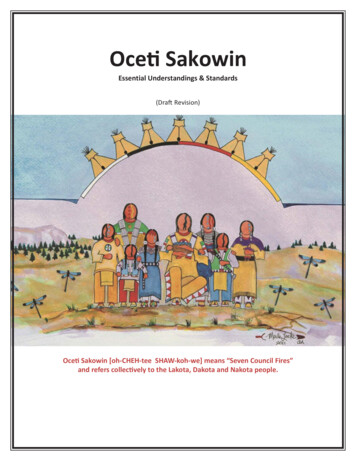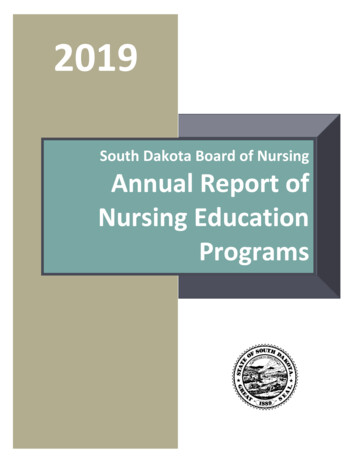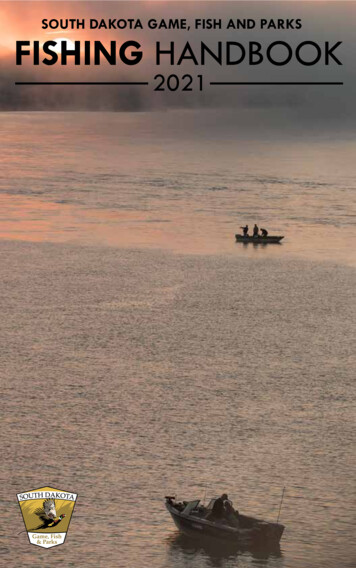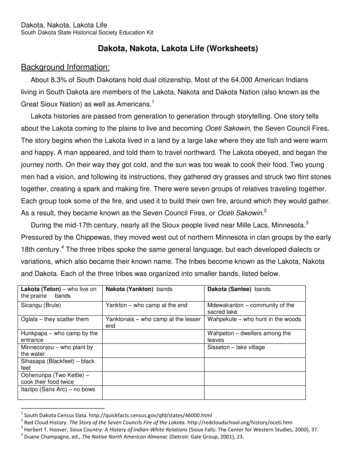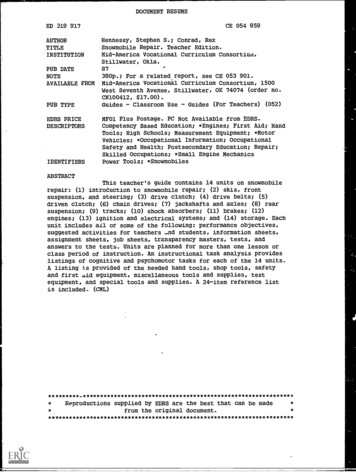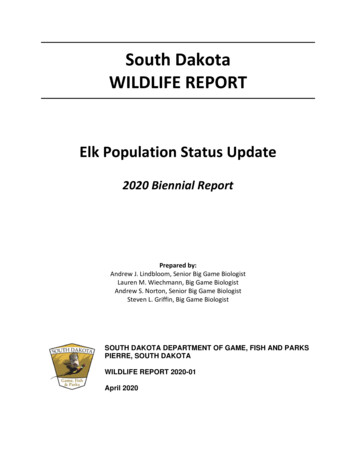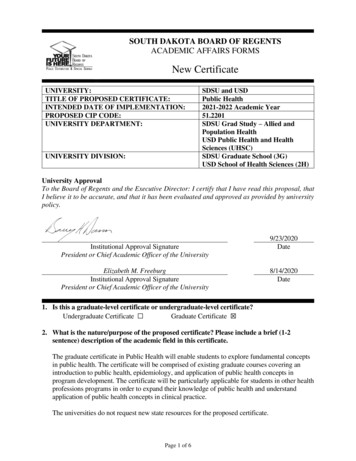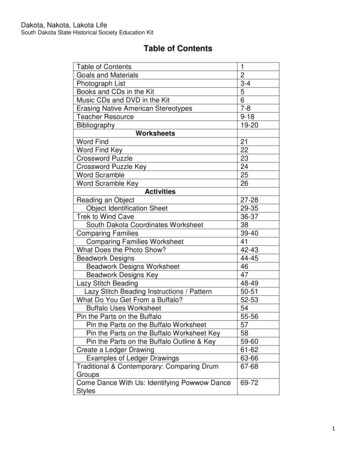
Transcription
Dakota, Nakota, Lakota LifeSouth Dakota State Historical Society Education KitTable of ContentsTable of ContentsGoals and MaterialsPhotograph ListBooks and CDs in the KitMusic CDs and DVD in the KitErasing Native American StereotypesTeacher ResourceBibliographyWorksheetsWord FindWord Find KeyCrossword PuzzleCrossword Puzzle KeyWord ScrambleWord Scramble KeyActivitiesReading an ObjectObject Identification SheetTrek to Wind CaveSouth Dakota Coordinates WorksheetComparing FamiliesComparing Families WorksheetWhat Does the Photo Show?Beadwork DesignsBeadwork Designs WorksheetBeadwork Designs KeyLazy Stitch BeadingLazy Stitch Beading Instructions / PatternWhat Do You Get From a Buffalo?Buffalo Uses WorksheetPin the Parts on the BuffaloPin the Parts on the Buffalo WorksheetPin the Parts on the Buffalo Worksheet KeyPin the Parts on the Buffalo Outline & KeyCreate a Ledger DrawingExamples of Ledger DrawingsTraditional & Contemporary: Comparing DrumGroupsCome Dance With Us: Identifying Powwow 56575859-6061-6263-6667-6869-721
Dakota, Nakota, Lakota LifeSouth Dakota State Historical Society Education KitGoals and MaterialsGoalsKit users will: explore the history and culture of the Dakota, Nakota and Lakota people understand the changes brought about by the shift from buffalo hunting to reservationlife appreciate that the Dakota, Nakota and Lakota culture is not something from the past,but is a living, growing and changing part of South Dakota’s culture today gain knowledge and experience in learning directly from objectsMaterialsThis kit contains:1 turtle shell1 teacher’s manual1 bow drill set1 flashdrive manual (in manual)1 star quilt24 photographs (in manual)1 turkey bone whistle10 postcards (in manual)1 drum & drumstick3 1925 SD road maps1 bone flesher4 books1 bladder bagThe Lakota Way (w/CD)1 buffalo hornThe Pine Ridge Porcupine (w/CD)2 buffalo hoovesShota and the Star Quilt2 buffalo dew clawsPowwow Country: People of the Circle3 buffalo foot bones1 “Uses of the Buffalo” poster2 bone paint brushes4 Powwow dance regalia posters1 buffalo tail2 beading style samples1 buffalo hide sample with hair1 sage sample1 buffalo hide sample w/o hair1 sweetgrass braid1 bag buffalo hair1 toy parfleche1 buffalo rib bone1 beaded turtle amulet1 sinew sample1 quilled medicine wheel1 pipestone sample1 quilled bag1 fur hair tie2 miniature shields1 buckskin doll1 pin-and-bone game8 CDsThe Lakota Way: Stories and Lessons for Living (with book)The Pine Ridge Porcupine (with book)Sons of the Oglalas: 12 Old Traditional Sioux SongsNative ThunderOld Style Hand Drum SongsFun Round Dance SongsWorld’s Best 49er SongsA Collection of Lakota Children’s Songs1 DVDSpirit of the Dance: Wacipi2
Dakota, Nakota, Lakota LifeSouth Dakota State Historical Society Education KitPhotograph List1. Little Crow, Ta Oyaleduta, was a leader of the Minnesota Uprising in 1862.A.Z. Shindler photo, 1858.National Anthropological Archives, Smithsonian Institution (photo no. 3505)2. Yankton chiefs gathered in Washington, D.C.A.Z. Shindler photo, 1867.National Anthropological Archives, Smithsonian Institution (photo no. 3636)3. Yankton chief Struck-by-the-Ree, Palaneapape. Legend says Struck-by-the-Ree was born whileLewis and Clark were meeting with the Yankton tribe. Lewis wrapped the child in an Americanflag.A.Z. Shindler photo, 1867.National Anthropological Archives, Smithsonian Institution (photo number 3545-A)4. Red Cloud, Mahpiya Luta, Oglala. Red Cloud led the campaign against white encroachment ontoIndian land in the 1860s that closed the Bozeman Trail.Charles M. Bell photo, 1880.National Anthropological Archives, Smithsonian Institution (photo no. 52,836)5. American Horse, Washicun Tashanka, Oglala, in Washington, D.C.D.S. Mitchell photo, 1877.National Anthropological Archives, Smithsonian Institution (photo number 3214-C)6. Spotted Tail, Sinte Gleska, Brule.Alexander Gardner photo, 1872.National Anthropological Archives, Smithsonian Institution (photo no. 3118)7. Miniconjou chief Hump sits on his horse with Scar Leg standing nearby, 1906.8. Big Turkey camp on the Rosebud reservation, c. 1905.unknown photographerSouth Dakota State Archives9. Beef issue day at Fort Yates, on the Standing Rock Reservation in the 1880s. Every two weeksthe cattle were corralled, shot, and the meat issued to families.National Anthropological Archives, Smithsonian Institution (photo number 54,510)10. Women preparing a feast.Bert Bell photo, 1928.William Groethe, Rapid City, SD11. Racks of corn drying by tipis, c. 1880s.unknown photographerNational Anthropological Archives, Smithsonian Institution (photo no. 56,631)12. Scraping a stretched buffalo hide, n.d.unknown photographerSouth Dakota State Archives13. Carrying water on the Pine Ridge Reservation, n.d.unknown photographerSouth Dakota State Archives3
Dakota, Nakota, Lakota LifeSouth Dakota State Historical Society Education Kit14. Horseman at Pine Ridge, 1900.unknown photographerSouth Dakota State Archives15. Horse pulling tent poles with sweat lodge frame in background, c. 1890s.unknown photographerNational Anthropological Archives, Smithsonian Institution (photo number 53,402-B)16. Children working in a garden at Pine Ridge, n.d.unknown photographerSouth Dakota State Archives17. A giveaway ceremony or wopila may be held in memory of a loved one who has died or to honora special event or achievement. The person or family being honored gives gifts to friends andrelatives.Bert Bell photo, 1928.William Groethe, Rapid City, SD18. Smallpox scars are evident on White Bird, c. 1890s.unknown photographerSouth Dakota State Archives19. Burial tree, n.d. The dead were buried by wrapping them in a buffalo robe and placing them in atree or on a scaffold out of the reach of wild animals. As the body decayed, it returned to nature.unknown photographerSouth Dakota State Archives20. Students in No. 29 Day School on the Pine Ridge Reservation, n.d.unknown photographerSouth Dakota State Archives21. Santee Normal School band at Niobrara, NE, n.d.unknown photographerSouth Dakota State Archives22. Benjamin Brave and his children, n.d. Benjamin had been a student at Hampton Institute inVirginia.unknown photographerNational Anthropological Archives, Smithsonian Institution (photo number 53,335)23. Jim and Alice Little Chief with their children Emma and John on the Rosebud Reservation, c.1905.unknown photographerSouth Dakota State Archives24. Lakota Sioux Ben Black Elk welcomed visitors to Mount Rushmore for many years. Pictured herec. 1950.unknown photographerSouth Dakota State Archives4
Dakota, Nakota, Lakota LifeSouth Dakota State Historical Society Education KitBooks and CDs in the KitThe best way to know what the Lakota language sounds like is to actually hear it spoken.Seeing the Lakota words written side-by-side with their English translations also makesunderstanding the language easier.The kit contains two picture books written in both English and Lakota with anaccompanying CD so kit users can see and hear the Lakota language. A third book, with aCD set, shares traditional Lakota stories. Another book tells about thirteen “moons” in aNative American year. The fifth book in the kit is a photo book of powwows across thenation.The Lakota Way: Stories and Lessons for Living Book and CD setWritten by Sicangu Lakota Joseph Marshall, The Lakota Way shares stories passed on toMarshall by his grandparents. The stories each illustrate an important Lakota virtue – love,compassion, respect, honor, generosity. In his introduction, Marshall writes, “By providing bothknowledge and inspiration, stories continue to strengthen Lakota society and enable us to cope withour world and the times we live in.”The Pine Ridge Porcupine Book and CD setAn illustrated story written in both English and Lakota side-by-side originally published in 1941as part of a series of bilingual reading books. The story tells about a porcupine who decides to trydoing quillwork himself rather than letting others use the quills he leaves behind.Shota and the Star QuiltAn illustrated story told side-by-side in English and Lakota about a young urban Lakota girlwho makes a star quilt that keeps her apartment building in the city from being torn down forredevelopment.Powwow Country: People of the CirclePowwow dancer and photographer Chris Roberts captures the exciting dance traditions, colorfulregalia and social connections enjoyed at powwows across the nation. Full-color photos. Used in theCome Dance With Us: Identifying Powwow Dance Styles activity.The Lakota Way, The Pine Ridge Porcupine and Shota and the Star Quilt are suitable for readingaloud.The Pine Ridge Porcupine can be set up as a listening center for an individual or small group to listento the CD while following along in the book.The stories on The Lakota Way CDs could be played for the class and the message of the storydiscussed.5
Dakota, Nakota, Lakota LifeSouth Dakota State Historical Society Education KitMusic CDs and DVD in the KitA Collection of Lakota Children’s Songs, Volume IProduced by the Lakota Language Consortium in 2009, this CD features common children’s songsincluding Itsy Bitsy Spider, Twinkle Twinkle Little Star and Bingo sung in Lakota.Sons of the Oglalas: 12 Old Traditional Sioux Songs of the Teton Oglala Lakota SiouxThe Sons of the Oglalas are a traditional drum group.Native ThunderNative Thunder is a contemporary Lakota drum group from Thunder Valley on the Pine Ridge IndianReservation. They were an invited guest drum at the 2005 Gathering of Nations Powwow, NorthAmerica's biggest powwow.Old Style Hand Drum SongsHand drums are probably the most common type of drum in North America. Hand drum music has aquicker beat and higher tone than that of large drums.Fun Round Dance SongsA Round or Social Dance is a friendship dance. Everyone is invited to join the circle and hold hands.Round Dances have a heavy one-two-one beat and dancers move clockwise around the circle.World’s Best 49er Songs49er songs are the social songs played at the Indian-only social gathering after a powwow ends. 49erparties are not considered part of the powwow itself. 49er songs are round dance style songs withcontemporary lyrics combined with vocables or with native language lyrics.Spirit of the Dance: WacipiSpirit of the Dance focuses on the dance styles and history of the Northern Plains Indians. TheDVD features footage of powwows from all over South Dakota. The DVD is used in the Come DanceWith Us: Identifying Powwow Dance Styles activity.The CDs and DVD could be listened to or viewed as a group or set up in a listening center. Some ofthem are used in specific kit activities as well.6
Dakota, Nakota, Lakota LifeSouth Dakota State Historical Society Education KitOnline at mlERASING NATIVE AMERICAN STEREOTYPESHow can we avoid stereotypes about Native Americans when we are teaching, selecting textbooks, or designingexhibits and public programs?Cultural institutions reflect current issues of society. Both museums and schools are wrestling with newsensitivities and concerns with cultural diversity. For instance, at a recent Smithsonian symposium onContemporary American Indian Art, several Native American artists asked why their paintings and sculptureare rarely shown at fine arts museums, but are more likely to be exhibited at anthropology and natural historymuseums. Native American artists also question why their work is not combined with other American artists'work in shows on American art (Kaupp, 1990).In directing an alternative school for Native American children in Chicago, June Sark Heinrich found manymisnomers and false ideas presented by teachers as they instructed students about the history and the heritage ofNative peoples. She devised ten classroom "don'ts" to help teachers correct these common errors. The D'ArcyMcNickle Center for the History of the American Indian at the Newberry Library in Chicago recently begandesigning a sample checklist for evaluating books about American Indian history.This Anthro.Notes Teacher's Corner combines the two approaches. The questions that follow provide teachersand museum educators with ways to evaluate their own teaching and criteria to evaluate the materials they use.1) Are Native Americans portrayed as real human beings with strengths and weaknesses, joys andsadnesses? Do they appear to have coherent motivations of their own comparable to those attributed tonon-Indians?2) In books, films, comic strips and curriculum materials, do Native Americans initiate actions based ontheir own values and judgments, rather than simply react to outside forces such as government pressureor cattle ranchers?3) Are stereotypes and clichés avoided? References should not be made to "obstacles to progress" or "noblesavages" who are "blood thirsty" or "child-like" or "spiritual" or "stoic". Native Americans should notlook like Hollywood movie "Indians," whether Tonto from the Lone Ranger days or Walt Disney'srecent portrayals. Native Americans are of many physical types and also have European, African orother ancestry. Just as all Europeans or African-Americans do not look alike, neither do NativeAmericans. Heinrich urges that television stereotypes should not go unchallenged. For example, "whenNative Americans fought, they were thought more savage' than the Europeans and were often less so.Help children understand that atrocities are a part of any war. In fact, war itself is atrocious. At least, theNative Americans were defending land they had lived on for thousands of years. If Native Americanswere not savage warriors,' neither were they noble savages.' They were no more nor less noble than therest of humanity." Television, especially old movies, often portrays the "Indian" speaking only a fewwords of English, often only "ugh." Yet anthropologists have carefully documented the complexity ofNative American languages. At least 350 different languages were spoken in North America whenWilliam Bradford and the rest of the Puritans first stepped ashore in Massachusetts. Stereotypes can bedefused if teachers check their own expressions and eliminate those such as "You act like a bunch ofwild Indians" or "You are an Indian giver." In a similar way, do not use alphabet cards that say A is forapple, B is for ball, and I is for Indians. It may seem trivial, but Heinrich argues that such a practiceequates a group of people with things.7
Dakota, Nakota, Lakota LifeSouth Dakota State Historical Society Education Kit4) If the material is fiction, are the characters appropriate to the situations and are interactions rooted in aparticular time and place? If they are, a particular group such as the Navajo or Chippewa living at aspecific moment in history will be more likely to be brought accurately to life.5) Do the materials and the teacher's presentation avoid loaded words (savage, buck, chief, squaw) and aninsensitive or offensive tone6) Are regional, cultural, and tribal differences recognized when appropriate? As everyone knows but doesnot always put into practice, before the Europeans came there were no people here that calledthemselves "Indians." Instead, there were and still are Navajo or Menominee or Hopi, or Dakota, orNisqually, or Tlingit, or Apache. Instead of teaching about generalized Indians or "Native Americans,"study the Haida, or Cree, or Seminole.7) Are communities presented as dynamic, evolving entities that can adapt to new conditions, migrate tonew areas, and keep control of their own destinies? Too many classroom materials still present NativeAmerican traditions as rigid, fixed, and fragile. For example, some filmstrips and books may have titleslike "How the Indians Lived," as though there are not any Indian people living today. In fact, over twomillion Native Americans live in what is now the United States, about half of them live in cities andtowns and the other half on reservations or in rural areas.8) Are historical anachronisms present? The groups living here prior to the 1540's did not have horses,glass beads, wheat, or wagons. Can your students determine why that is the case and do they understandthat these items were all introduced by Europeans?9) Are captions and illustrations specific and appropriate for a specific time and place? (Wrapped skirts inthe Arctic, feather bonnets in the North Pacific Coast, or totem poles in the Plains never existed.) Areindividuals identified by name when possible?10) Are the different Native Americans viewed as heirs of a dynamic historical tradition extending backbefore contact with Europeans? Similarly, Native American groups should not be equated with otherethnic minorities. The fact is that Native American tribes--by treaty rights--own their own lands andhave other rights that are unique to the descendants of the real Natives of America, because they are that.No other minority within the United States is in a similar legal position. Native peoples view themselvesas separate nations within a nation. U.S. laws and treaties, officially endorsed by U.S. presidents and theCongress, confirm that status.11) If you have Native American children in your class, do not assume that they know all about their ownancestry and the ancestry of all Native Americans. All children including Native American childrenneed to be taught about the Native American heritage, which, in a very real sense, is the heritage ofeverybody living in the U.S. today. Culture and ideas, after all, are learned and not inherent from birth.References:"Checklist," Meeting Ground, Biannual Newsletter of the D'Arcy McNickle Center, Issue 23, Summer 1990. The Newberry Library, 60 West WaltonStreet, Chicago, Illinois 60610-3380. ("Checklist" was based on criteria provided by Center advisor, Cheryl Metoyer-Duran, UCLA School ofLibrary and Information Sciences.)Heinrich, June Sark. "Native Americans: What Not to Teach," Unlearning "Indian" Stereotypes, A Teaching Unit forElementary Teachers andChildren's Librarians. New York, NY: The Racism and Sexism Resource Center For Educators, a Division of The Council on Interracial Books forChildren, 1977.Kaupp, Ann. "Toward Gender and Ethnic Equity in Museums." Four Star, Newsletter for the Smithsonian Institution Women's Council10(2), Summer 1990.JoAnne Lanouette(Originally published as the Teacher's Corner in the fall 1990 issue of Anthro.Notes, vol. 12, no. 3.)ANTHROPOLOGY OUTREACH OFFICE NATIONAL MUSEUM OF NATURAL HISTORY 1996Last Updated: January 30, 1999.8
Dakota, Nakota, Lakota LifeSouth Dakota State Historical Society Education KitTeacher ResourceAbout 8.7% of South Dakotans hold dual citizenship. Most of the 71,700 American Indiansliving in South Dakota are members of the Lakota, Nakota and Dakota Nation (also known as theGreat Sioux Nation) as well as Americans.1Lakota histories are passed from generation to generation through storytelling. One story tellsabout the Lakota coming to the plains to live and becoming Oceti Sakowin, the Seven Council Fires.The story begins when the Lakota lived in a land by a large lake where they ate fish and were warmand happy. A man appeared, and told them to travel northward. The Lakota obeyed, and began thejourney north. On their way they got cold, and the sun was too weak to cook their food. Two youngmen had a vision, and following its instructions, they gathered dry grasses and struck two flint stonestogether, creating a spark and making fire. There were seven groups of relatives traveling together.Each group took some of the fire, and used it to build their own fire, around which they would gather.As a result, they became known as the Seven Council Fires, or Oceti Sakowin.2During the mid-17th century, nearly all the Sioux people lived near Mille Lacs, Minnesota.3Pressured by the Chippewas, they moved west out of northern Minnesota in clan groups by the early18th century.4 The three tribes spoke the same general language, but each developed dialects orvariations, which also became their known name. The tribes become known as the Lakota, Nakotaand Dakota. Each of the three tribes was organized into smaller bands, listed below.Lakota (Teton) – who live onthe prairie bandsNakota (Yankton) bandsDakota (Santee) bandsSicangu (Brule)Yankton – who camp at the endOglala – they scatter themYanktonais – who camp at the lesserendMdewakanton – community of thesacred lakeWahpekute – who hunt in the woodsHunkpapa – who camp by theentranceMinneconjou – who plant bythe waterSihasapa (Blackfeet) – blackfeetOohenunpa (Two Kettle) –cook their food twiceItazipo (Sans Arc) – no bowsWahpeton – dwellers among theleavesSisseton – lake village1South Dakota Census Data. http://factfinder.census.govRed Cloud History. The Story of the Seven Councils Fire of the Lakota. t T. Hoover, Sioux Country: A History of Indian-White Relations (Sioux Falls: The Center for Western Studies, 2000), 37.4Duane Champagne, ed., The Native North American Almanac (Detroit: Gale Group, 2001), 23.29
Dakota, Nakota, Lakota LifeSouth Dakota State Historical Society Education KitLakotaOne of the earlier clans to leave Minnesota was the Lakota, including the Teton band. Theysettled in the Sioux and James River valleys during the 18th century, then pushed west past theMissouri River. The Lakota creation story tells how they came to hunt the buffalo.The Great Spirit Skan made us with bones from Stone, bodies from Earth, and soulsfrom himself, Wind and Thunders. The gifts of Sun, Wisdom, Moon, and Revealer gaveus life. A council of the spirits named us Pte Oyate–Buffalo Nation—and told us to carefor the spirits. One day Spider sent Wolf to the Underworld to tell Tokahe that life wouldbe easier on the surface of the earth. Tokahe ignored the warnings of the holy manTatanka, and led the people up through Wind Cave. Life there was hard, so Tatankacame to help—as a great shaggy beast. Since then the people have lived here with thebuffalo.5Every Lakota person has many relatives. All of them are part of his/her tiyospaye, the circle ofrelatives including mother, father, grandfather, grandmother, aunts, uncles, cousins and all relativesfrom marriage and adoption. When you know your relatives, you know where you come from and whoyou are. Kinship provides direction for daily living. All values and judgments of right and wrong relateto the duties and benefits of kinship. Each member of the group must act to insure the good of thetiyospaye.NakotaBy 1708, the Nakota, which included the Yankton band, had moved from their Minnesota home tothe northwestern corner of Iowa.6 By 1804, they had moved further west to the mouth of the JamesRiver where they met Lewis and Clark.7 By 1857, tensions rose between the Nakota and whitesettlers trespassing on tribal land. Chief Struck By The Ree went to Washington, DC, where he andother tribal leaders signed a treaty ceding the eastern half of South Dakota to the US government. 8The treaty relocated the Nakota from Yankton west to Wagner, SD.The Nakota never officially took up arms against the United States. They did sometimes fall victimto angry whites who punished them anyway, as did Fort Randall soldiers soon after the 1862Minnesota Uprising when they killed a Nakota hunting party that had legal permission to hunt in thearea.95South Dakota State Historical Society. Lakota Creation Story. http://travelsd.com/onlyinsd/sioux/Elmer Duane Cwach, “A History of the Yankton Indian Agency During the Nineteeth Century,” (MA Thesis, South Dakota StateUniversity, 1958), 1.7Harry H. Anderson, “The Diplomacy of Lewis and Clark among the Teton Sioux, 1804-1807,” South Dakota History 35, no. 1 (Spring2005), 41.8Hoover, Sioux Country, 53.9Cwach, “History of the Yankton Indian Agency,” 22.610
Dakota, Nakota, Lakota LifeSouth Dakota State Historical Society Education KitDakotaThe Dakota, or Santee, along with the Nakota formed the eastern Sioux tribes. Dakota means"Allies" or "Confederates," expressing their close ties with the Nakota and the Lakota, the westernSioux tribe. The Santee stayed in Minnesota until 1862, when they fought a desperate war with thewhites who were pushing them into smaller plots of land. After numerous treaties, they had so littleland left that they could not sustain themselves. The US government promised money and food forthe land, but the payments were so late the Santee were dying of starvation. The neglect worsenedafter the government became preoccupied with fighting the Civil War.10 After many years of starvationand disappointment, the Santee demanded help in feeding their families in 1862. Violence broke outand the Minnesota Uprising lasted about 40 days, taking hundreds of lives. Afterward, the whiteswanted revenge on the Santee, both guilty and innocent. Many Santee fled west to escape the angrywhites. Those who stayed in Minnesota were held responsible. About 1,700 Santee were capturedand put in prison and over three hundred were sentenced to hang. President Lincoln called for acareful review of the evidence, and the number hanged was reduced to thirty-eight.11 When thesentence was carried out on December 26, 1862, it was the largest mass execution in United Stateshistory.Forced Santee RelocationFollowing the Minnesota Uprising, 1,300 Santee were relocated to Crow Creek in DakotaTerritory, near Fort Thompson. Special Agent Ben Thompson had chosen the site, just weeks beforethe Santee arrived, with a priority on isolation from white settlements. He defended his choice foryears, saying it was suitable, but few would agree. The land was sparsely wooded, especiallycompared to Minnesota. Since hundreds of their able men had been sentenced to prison in Iowa, thenew arrivals were mostly women and children. They arrived already weakened and sick from crowdedtravel. Many had died along the way, and about 300 died from starvation, disease, and exposure thefirst year at Crow Creek.12While their women and children were shipped to Crow Creek, about two hundred Santee menwere sent to prison at Fort McClellen, Iowa. There many of the prisoners converted to Christianity andmixed freely with surrounding white neighbors, learning farming skills.13 By the spring of 1865, most10ndRoy W. Meyer, History of the Santee Sioux, 2 ed. (Lincoln, NE: University of Nebraska Press, 1993), 112.Champagne, Native American Almanac, 42.12Meyer, Santee Sioux, 146.13Paul Stuart, ed., Dacotah: A History of the Flandreau Santee Sioux (Flandreau, SD: Tribal History Program, Flandreau Sioux Tribe,1971), 53.1111
Dakota, Nakota, Lakota LifeSouth Dakota State Historical Society Education Kitof the prisoners were returning north to Dakota in time to meet their families moving south from CrowCreek to a new reservation on the Niobrara River bordering Nebraska. Although some of the Santeeliked Niobrara, the government was years away from declaring it their permanent reservation. Thisuncertainty of a title to their home, in addition to a desire to live closer to the Minnesota borderprevented some of them from putting down roots.14 By the spring of 1869, twenty-five families leftNiobrara to establish a colony on the banks of the Big Sioux River. These families became theFlandreau Indian settlement, comprised mostly of heads of household who had learned white wayswhile imprisoned in Iowa.15Two other Dakota bands, the Sissetons and Wahpetons, though largely innocent of participatingin the Minnesota Uprising, had fled Minnesota and eventually settled the area west of Lake Traverseand Big Stone Lake by 1864. Fort Wadsworth, later renamed Fort Sisseton, was established neartheir settlement.16Traditional Village LifeOn the plains, the horse culture of the Lakota thrived. Life centered on the buffalo, whichprovided food and shelter. Other foodstuffs included prairie turnips, chokecherries, other wild game,and fish. Trade with the earth lodge tribes along the upper Missouri River brought in corn, beans, andsquash.The four seasons set the rhythm for village life. In the spring, women repaired or replaced tipis,and made clothing. They began gathering ripening berries and roots. For the men, spring brought thefirst buffalo hunts. It was also a time for repairing weapons, hunting other game, and hide painting.Socially, springtime meant dances sponsored by various tribal groups, and vision seeking. 17Summer brought more buffalo hunting to ensure the winter food supply. It was also a time forraiding parties to set out, and for trading with other tribes. Ceremonies such as the Sun Dance wereheld in the summer. Camp had to be moved every few days to follow the buffalo and reach newgrazing land for the horses. Tipis provided good easily moved shelter. The main components of thetipi were the poles, the hide cover, a liner, and anchoring stakes or stones. Women made and ownedthe tipis. A family of eight could live comfortably in a 14-foot tipi.To set up the tipi, three poles were tied together to form a tripod. Other poles were laid againstthe tripod to form a sturdy frame. The tipi’s hide cover, made from sewing buffalo hides into a14Stuart, Dacotah, 63.Ibid., 71.16Meyer, Santee Sioux, 198.17Thomas E. Mails, The Mystic Warriors of the Plains (New York: Mallard Press, 1991), 25.1512
Dakota, Nakota, Lakota LifeSouth Dakota State Historical Society Education Kitsemicircle, was tied to the last post and pushed into place. Once spread over the poles, the coverwas laced together in front with wooden pins. The tipi cover was staked down or anchored withstones around the edge to hold it in place. Smoke flaps on top of the tipi could be adjusted forventilation and protection from the rain. An interior liner was tied to the tipi poles. This providedprivacy since when the central fire was lit, shadows would be cast on the liner and not on the outsidetipi cover. Grass stuffed be
Jan 30, 1999 · The Lakota Way, The Pine Ridge Porcupine and Shota and the Star Quilt are suitable for reading aloud. The Pine Ridge Porcupine can be set up as a listening center for an individual or small group to listen to the CD while following along in the book. The stories on The Lakota Way CDs could

